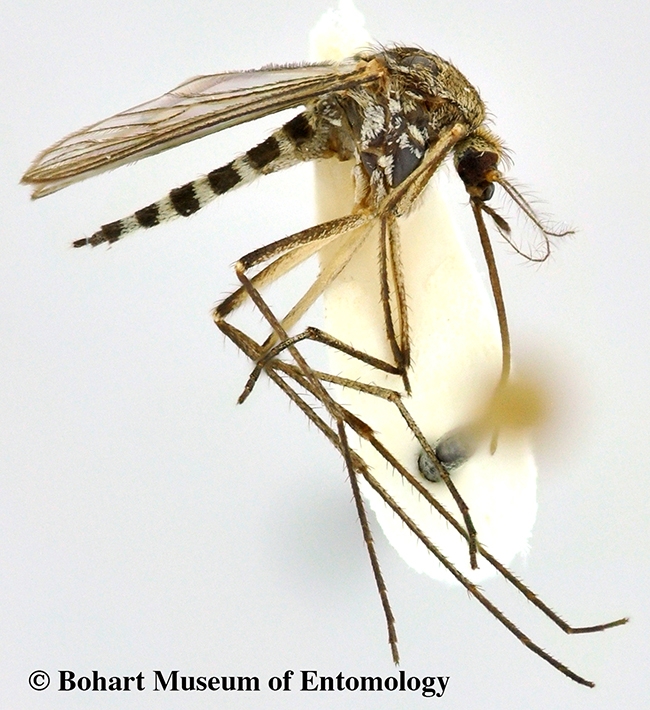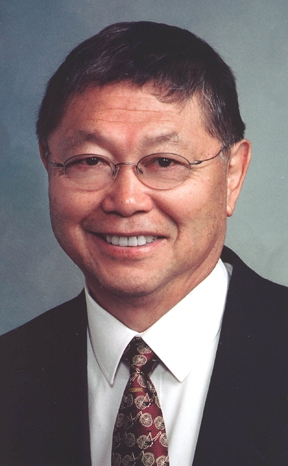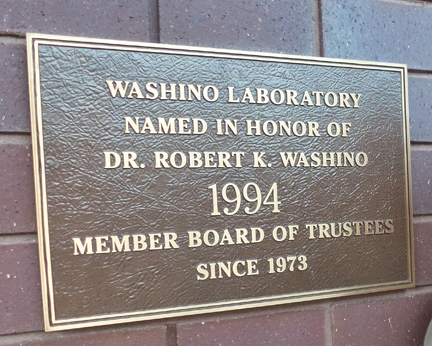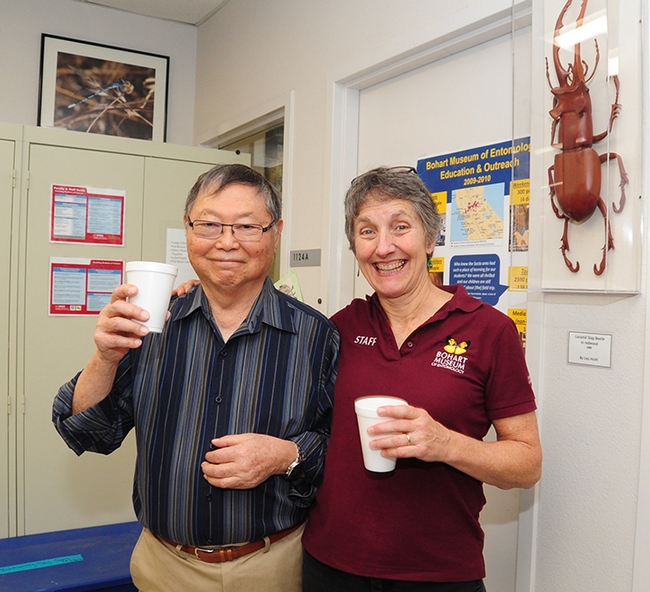
Noted medical entomologist Robert "Bob" Washino, emeritus professor of entomology and a veteran academic administrator at UC Davis, was hanging out in his back yard in Davis last spring when an aedine mosquito bit him.
He wondered whether it might be associated with the Zika virus so he headed over to the Bohart Museum of Entomology at UC Davis and handed the specimen to fellow mosquito researcher Tom Zavortink.
"The truth of the matter is that I was concerned that the mosquito biting me was either aegypti or albopictus associated with the Zika virus that is raising commotion all over the U.S. and the world," Washino related. "For that reason, I took the specimen to the museum and asked Tom Z. to identify the specimen, and of course, he excused himself from the meeting he was involved in, and examined the mosquito. When he completed the examination, he looked up at me and just smiled."
The mosquito: Aedes washinoi. Bob Washino's namesake.
"I loved the irony of it all," said his close friend Lynn Kimsey, director of the Bohart Museum and professor of entomology at UC Davis. "Bob Washino being bitten by Aedes washinoi in the Washino yard! Truly awesome."
Aedes washinoi is one of five mosquitoes named for former University of California faculty:
- Anopheles hermsi: for William B. Herms (1876-1949), UC Berkeley
- Anopheles freeborni, for Stanley Freeborn (1891-1960), first UC Davis chancellor (1958-59)
- Culex boharti: for Richard Bohart (1913-2007) UC Davis, for whom the Bohart Museum of Entomology is named
- Culex reevesi for William Reeves, (1916-2004), UC Berkeley
- Aedes washinoi for Robert Washino, UC Davis

UC Davis medical entomologists Bruce Eldridge (now emeritus) and Gregory Lanzaro named the mosquito in his honor in 1992.
Born and reared in Sacramento, Washino never strayed far from his roots, except for two years in France as a medical entomologist with the Army Medical Service Corps, 1956-1958, during the Korean War. His parents, natives of Japan, grew hops on their farm in the Sacramento Valley. Later his father became a successful Sacramento florist shop and hotel owner.
Washino said a career in biomedical sciences always intrigued him, “but there was no one event that led me to a career in medical entomology. I just happened to be at the right place at the right time.” He received his bachelor of science degree in 1954 from UC Berkeley; his master's degree in entomology from UC Davis in 1956; and his doctorate in entomology from UC Davis in 1967.
His career at UC Davis spanned 30 years, from 1964-1994. That included multiple terms as chair of the UC Davis Department of Entomology (now the UC Davis Department of Entomology and Nematology) and he also served as an associate dean of the UC Davis College of Agricultural and Environmental Sciences and as a special assistant. He is a past president of both the American Mosquito Control Association and the California Mosquito and Vector Control Association, and co-author of Mosquitoes of California with Richard Bohart. He is a fellow of the Entomological Society of America.

More locally, he was appointed by the City of Davis to the Sacramento-Yolo Mosquito and Vector Control District's Board of Trustees in 1973 and served 38 years, longer than any other trustee. He was elected president five times. For research and teaching purposes, he generously gifted his entire collection of books and journals, reprints, unpublished master of science and doctorate theses (from UC Davis, UCLA, UC Riverside) and an estimated 1000 2x2 slides to the library. The building that houses the library, laboratory and lab staff bears his name, the Washino Laboratory.
One of the many highlights of his career: Washino received the prestigious Harry Hoogstraal Medal from the American Committee of Medical Entomology at the 54th annual meeting of the American Society for Tropical Medicine and Hygiene (ASTMH), held in December 2005 in Washington, D.C.
In 2010, Washino coordinated an all-day mosquito symposium at the American Mosquito Control Association's five-day conference in Anaheim, Orange County. He gathered together 17 U.S. and worldwide speakers, including experts from London, Japan, Australia, Portugal and Germany.
And then, six years later...what are the odds? His namesake, Aedes washinoi, bit him in his own back yard.
"I think Lynn really enjoyed the irony of that incident," Washino said, smiling, "and we all had a big laugh at my expense."
Related Link:
Medical Entomologist Robert Washino Retires from Sacramento-Yolo Mosquito District Board
Robert Washino Wins Harry Hoogstraal Medal for Outstanding Achievement in Medical Entomology
Attached Images:
